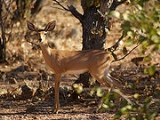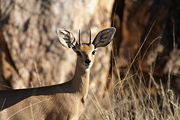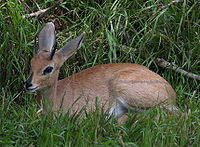
Steenbok
Encyclopedia
The Steenbok, Raphicerus campestris, is a common small antelope
of southern and eastern Africa. It is sometimes known as the Steinbuck or Steinbok.
 Steenbok resemble small Oribi
Steenbok resemble small Oribi
, standing 45–60 cm at the shoulder. Their pelage (coat) is any shade from fawn to rufous, typically rather orange. The underside, including chin and throat, is white, as is the ring around the eye. Ears are large with "finger-marks" on the inside. Males carry straight, smooth, parallel horns
7–19 cm long (see image left). There is a black crescent-shape between the ears, a long black bridge to the glossy black nose, and a black circular scent-gland in front of the eye. The tail is not usually visible, being only 4–6 cm long.
, it occurs in southern Kenya
and Tanzania
. It was formerly widespread in Uganda
, but is now possibly extinct there. In southern Africa
, it occurs in Angola
, Namibia
, South Africa
, Swaziland
, Botswana
, Mozambique
, Zambia
, Zimbabwe
and probably Lesotho
.
s from semi-desert, such as the edge of the Kalahari Desert
and Etosha National Park
, to open woodland and thickets, including open plain
s, stony savanna
h, and Acacia
–grassland
mosaic
s. They are said to favour unstable or transitional habitats. At least in the central part of Kruger National Park
, South Africa, Steenbok show a distinct preference for Acacia tortilis
savannah throughout the year, with no tendency to migrate to moister areas in the dry season (unlike many African savannah ungulates, including species sympatric with Steenbok in the wet season).
s, and then woody plants (especially Flueggea virosa
) when few forbs are available. They will also take fruits and only very rarely graze on grass
. They are almost entirely independent of drinking water, gaining the moisture they need from their food.
or taking brief spells of sleep.
 At the first sign of trouble, Steenbok typically lie low in the vegetation. If a predator or perceived threat comes closer, a Steenbok will leap away and follow a zigzag route to try to shake off the pursuer. Escaping Steenbok frequently stop to look back, and flight is alternated with prostration during extended pursuit. They are known to take refuge in the burrows of Aardvarks. Known predators include African Wild Cat
At the first sign of trouble, Steenbok typically lie low in the vegetation. If a predator or perceived threat comes closer, a Steenbok will leap away and follow a zigzag route to try to shake off the pursuer. Escaping Steenbok frequently stop to look back, and flight is alternated with prostration during extended pursuit. They are known to take refuge in the burrows of Aardvarks. Known predators include African Wild Cat
, Caracal
, Jackals, Leopard
, Martial Eagle
and Pythons.
. However, it has been suggested that pairs occupy consistent territories
while living independently, staying in contact through scent markings, so that they know where their mate is most of the time. Scent marking is primarily through dung midden
s. Territories range from 4 hectares to one square kilometre. The male is aggressive during the female's oestrus, engaging in "bluff-and-bluster" type displays with rival males—prolonged contests invariably involve well-matched individuals, usually in their prime.
Breeding occurs throughout the year, although more fawns are born November to December in the southern spring–summer; some females may breed twice a year. Gestation period
is about 170 days, and usually a single precocious
fawn is produced. The fawn is kept hidden in vegetation for 2 weeks, but they suckle for 3 months. Females become sexually mature at 6–8 months and males at 9 months.
Steenbok are known to live for 7 years or more.
 Two subspecies
Two subspecies
are recognized: R. c. campestris in Southern Africa and R. c. naumanni of East Africa; although MSW3 also recognizes capricornis and kelleni. Up to 24 subspecies have been described from Southern Africa, distinguished on such features as coat colour.
Antelope
Antelope is a term referring to many even-toed ungulate species indigenous to various regions in Africa and Eurasia. Antelopes comprise a miscellaneous group within the family Bovidae, encompassing those old-world species that are neither cattle, sheep, buffalo, bison, nor goats...
of southern and eastern Africa. It is sometimes known as the Steinbuck or Steinbok.
Description

Oribi
Oribi are graceful slender-legged, long-necked small antelope found in grassland almost throughout Sub-Saharan Africa.-Description:...
, standing 45–60 cm at the shoulder. Their pelage (coat) is any shade from fawn to rufous, typically rather orange. The underside, including chin and throat, is white, as is the ring around the eye. Ears are large with "finger-marks" on the inside. Males carry straight, smooth, parallel horns
Horn (anatomy)
A horn is a pointed projection of the skin on the head of various animals, consisting of a covering of horn surrounding a core of living bone. True horns are found mainly among the ruminant artiodactyls, in the families Antilocapridae and Bovidae...
7–19 cm long (see image left). There is a black crescent-shape between the ears, a long black bridge to the glossy black nose, and a black circular scent-gland in front of the eye. The tail is not usually visible, being only 4–6 cm long.
Distribution
There are two distinct clusters in Steenbok distribution. In East AfricaEast Africa
East Africa or Eastern Africa is the easterly region of the African continent, variably defined by geography or geopolitics. In the UN scheme of geographic regions, 19 territories constitute Eastern Africa:...
, it occurs in southern Kenya
Kenya
Kenya , officially known as the Republic of Kenya, is a country in East Africa that lies on the equator, with the Indian Ocean to its south-east...
and Tanzania
Tanzania
The United Republic of Tanzania is a country in East Africa bordered by Kenya and Uganda to the north, Rwanda, Burundi, and the Democratic Republic of the Congo to the west, and Zambia, Malawi, and Mozambique to the south. The country's eastern borders lie on the Indian Ocean.Tanzania is a state...
. It was formerly widespread in Uganda
Uganda
Uganda , officially the Republic of Uganda, is a landlocked country in East Africa. Uganda is also known as the "Pearl of Africa". It is bordered on the east by Kenya, on the north by South Sudan, on the west by the Democratic Republic of the Congo, on the southwest by Rwanda, and on the south by...
, but is now possibly extinct there. In southern Africa
Southern Africa
Southern Africa is the southernmost region of the African continent, variably defined by geography or geopolitics. Within the region are numerous territories, including the Republic of South Africa ; nowadays, the simpler term South Africa is generally reserved for the country in English.-UN...
, it occurs in Angola
Angola
Angola, officially the Republic of Angola , is a country in south-central Africa bordered by Namibia on the south, the Democratic Republic of the Congo on the north, and Zambia on the east; its west coast is on the Atlantic Ocean with Luanda as its capital city...
, Namibia
Namibia
Namibia, officially the Republic of Namibia , is a country in southern Africa whose western border is the Atlantic Ocean. It shares land borders with Angola and Zambia to the north, Botswana to the east and South Africa to the south and east. It gained independence from South Africa on 21 March...
, South Africa
South Africa
The Republic of South Africa is a country in southern Africa. Located at the southern tip of Africa, it is divided into nine provinces, with of coastline on the Atlantic and Indian oceans...
, Swaziland
Swaziland
Swaziland, officially the Kingdom of Swaziland , and sometimes called Ngwane or Swatini, is a landlocked country in Southern Africa, bordered to the north, south and west by South Africa, and to the east by Mozambique...
, Botswana
Botswana
Botswana, officially the Republic of Botswana , is a landlocked country located in Southern Africa. The citizens are referred to as "Batswana" . Formerly the British protectorate of Bechuanaland, Botswana adopted its new name after becoming independent within the Commonwealth on 30 September 1966...
, Mozambique
Mozambique
Mozambique, officially the Republic of Mozambique , is a country in southeastern Africa bordered by the Indian Ocean to the east, Tanzania to the north, Malawi and Zambia to the northwest, Zimbabwe to the west and Swaziland and South Africa to the southwest...
, Zambia
Zambia
Zambia , officially the Republic of Zambia, is a landlocked country in Southern Africa. The neighbouring countries are the Democratic Republic of the Congo to the north, Tanzania to the north-east, Malawi to the east, Mozambique, Zimbabwe, Botswana and Namibia to the south, and Angola to the west....
, Zimbabwe
Zimbabwe
Zimbabwe is a landlocked country located in the southern part of the African continent, between the Zambezi and Limpopo rivers. It is bordered by South Africa to the south, Botswana to the southwest, Zambia and a tip of Namibia to the northwest and Mozambique to the east. Zimbabwe has three...
and probably Lesotho
Lesotho
Lesotho , officially the Kingdom of Lesotho, is a landlocked country and enclave, surrounded by the Republic of South Africa. It is just over in size with a population of approximately 2,067,000. Its capital and largest city is Maseru. Lesotho is a member of the Commonwealth of Nations. The name...
.
Habitat
Steenbok can use a variety of habitatHabitat
* Habitat , a place where a species lives and grows*Human habitat, a place where humans live, work or play** Space habitat, a space station intended as a permanent settlement...
s from semi-desert, such as the edge of the Kalahari Desert
Kalahari Desert
The Kalahari Desert is a large semi-arid sandy savannah in Southern Africa extending , covering much of Botswana and parts of Namibia and South Africa, as semi-desert, with huge tracts of excellent grazing after good rains. The Kalahari supports more animals and plants than a true desert...
and Etosha National Park
Etosha National Park
Etosha National Park is a national park in the Kunene Region of northwestern Namibia. The park shares boundaries with the regions of Oshana, Oshikoto and Otjozondjupa....
, to open woodland and thickets, including open plain
Plain
In geography, a plain is land with relatively low relief, that is flat or gently rolling. Prairies and steppes are types of plains, and the archetype for a plain is often thought of as a grassland, but plains in their natural state may also be covered in shrublands, woodland and forest, or...
s, stony savanna
Savanna
A savanna, or savannah, is a grassland ecosystem characterized by the trees being sufficiently small or widely spaced so that the canopy does not close. The open canopy allows sufficient light to reach the ground to support an unbroken herbaceous layer consisting primarily of C4 grasses.Some...
h, and Acacia
Acacia
Acacia is a genus of shrubs and trees belonging to the subfamily Mimosoideae of the family Fabaceae, first described in Africa by the Swedish botanist Carl Linnaeus in 1773. Many non-Australian species tend to be thorny, whereas the majority of Australian acacias are not...
–grassland
Grassland
Grasslands are areas where the vegetation is dominated by grasses and other herbaceous plants . However, sedge and rush families can also be found. Grasslands occur naturally on all continents except Antarctica...
mosaic
Mosaic
Mosaic is the art of creating images with an assemblage of small pieces of colored glass, stone, or other materials. It may be a technique of decorative art, an aspect of interior decoration, or of cultural and spiritual significance as in a cathedral...
s. They are said to favour unstable or transitional habitats. At least in the central part of Kruger National Park
Kruger National Park
Kruger National Park is one of the largest game reserves in Africa. It covers and extends from north to south and from east to west.To the west and south of the Kruger National Park are the two South African provinces of Limpopo and Mpumalanga. In the north is Zimbabwe, and to the east is...
, South Africa, Steenbok show a distinct preference for Acacia tortilis
Acacia tortilis
Acacia tortilis, the Umbrella Thorn Acacia, also known as Umbrella Thorn and Israeli Babool, is a medium to large canopied tree native primarily to the savanna and Sahel of Africa , but also occurring in the Middle East....
savannah throughout the year, with no tendency to migrate to moister areas in the dry season (unlike many African savannah ungulates, including species sympatric with Steenbok in the wet season).
Diet
Steenbok typically browse on low-level vegetation (they cannot reach above 0.9 m), but are also adept at scraping up roots and tubers. In central Kruger National Park, Steenbok show a distinct preference for forbForb
A forb is a herbaceous flowering plant that is not a graminoid . The term is used in biology and in vegetation ecology, especially in relation to grasslands and understory.-Etymology:...
s, and then woody plants (especially Flueggea virosa
Bushweed
Flueggea, the Bushweeds, is a genus of plants in the family Phyllanthaceae, comprising several much-ramified shrubs to large trees distributed throughout the Eastern Hemisphere's tropical zones...
) when few forbs are available. They will also take fruits and only very rarely graze on grass
Grass
Grasses, or more technically graminoids, are monocotyledonous, usually herbaceous plants with narrow leaves growing from the base. They include the "true grasses", of the Poaceae family, as well as the sedges and the rushes . The true grasses include cereals, bamboo and the grasses of lawns ...
. They are almost entirely independent of drinking water, gaining the moisture they need from their food.
Behavior
During cool periods, Steenbok are active throughout the day; however, during hotter periods, they rest under shade during the heat of the day. While resting, they may be busy grooming, ruminatingRuminant
A ruminant is a mammal of the order Artiodactyla that digests plant-based food by initially softening it within the animal's first compartment of the stomach, principally through bacterial actions, then regurgitating the semi-digested mass, now known as cud, and chewing it again...
or taking brief spells of sleep.
Anti-predator

African wild cat
The African wildcat is a wildcat subspecies that occurs across northern Africa and extends around the periphery of the Arabian Peninsula to the Caspian Sea. As it is the most common and widely distributed wild cat, it is listed as Least Concern by IUCN since 2002.African wildcats appear to have...
, Caracal
Caracal
The caracal is a fiercely territorial medium-sized cat ranging over Western Asia, South Asia and Africa.The word caracal comes from the Turkish word "karakulak", meaning "black ear". In North India and Pakistan, the caracal is locally known as syahgosh or shyahgosh, which is a Persian term...
, Jackals, Leopard
Leopard
The leopard , Panthera pardus, is a member of the Felidae family and the smallest of the four "big cats" in the genus Panthera, the other three being the tiger, lion, and jaguar. The leopard was once distributed across eastern and southern Asia and Africa, from Siberia to South Africa, but its...
, Martial Eagle
Martial Eagle
The Martial Eagle , is a very large eagle found in open and semi-open habitats of sub-Saharan Africa. It is the only member of the genus Polemaetus.-Description:...
and Pythons.
Breeding
Steenbok are typically solitary, except for when a pair come together to mateMating
In biology, mating is the pairing of opposite-sex or hermaphroditic organisms for copulation. In social animals, it also includes the raising of their offspring. Copulation is the union of the sex organs of two sexually reproducing animals for insemination and subsequent internal fertilization...
. However, it has been suggested that pairs occupy consistent territories
Territory (animal)
In ethology the term territory refers to any sociographical area that an animal of a particular species consistently defends against conspecifics...
while living independently, staying in contact through scent markings, so that they know where their mate is most of the time. Scent marking is primarily through dung midden
Dung midden
Dung middens, also known as dung hills, are piles of dung that mammals periodically return to and build up. They are used as a form of territorial marker...
s. Territories range from 4 hectares to one square kilometre. The male is aggressive during the female's oestrus, engaging in "bluff-and-bluster" type displays with rival males—prolonged contests invariably involve well-matched individuals, usually in their prime.
Breeding occurs throughout the year, although more fawns are born November to December in the southern spring–summer; some females may breed twice a year. Gestation period
Gestation period
For mammals the gestation period is the time in which a fetus develops, beginning with fertilization and ending at birth. The duration of this period varies between species.-Duration:...
is about 170 days, and usually a single precocious
Precocious puberty
As a medical term, precocious puberty describes puberty occurring at an unusually early age. In most of these children, the process is normal in every respect except the unusually early age, and simply represents a variation of normal development. In a minority of children, the early development is...
fawn is produced. The fawn is kept hidden in vegetation for 2 weeks, but they suckle for 3 months. Females become sexually mature at 6–8 months and males at 9 months.
Steenbok are known to live for 7 years or more.
Taxonomy

Subspecies
Subspecies in biological classification, is either a taxonomic rank subordinate to species, ora taxonomic unit in that rank . A subspecies cannot be recognized in isolation: a species will either be recognized as having no subspecies at all or two or more, never just one...
are recognized: R. c. campestris in Southern Africa and R. c. naumanni of East Africa; although MSW3 also recognizes capricornis and kelleni. Up to 24 subspecies have been described from Southern Africa, distinguished on such features as coat colour.

